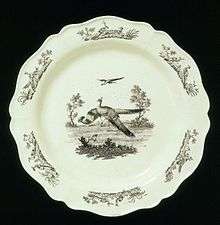Creamware

Creamware is a cream-coloured, refined earthenware with a lead glaze over a pale body, known in France as faïence fine,[1] in Germany as Engels porselein and Italy as terraglia inglese.[2] It was created about 1750 by the potters of Staffordshire, England, who refined the materials and techniques of salt-glazed earthenware towards a finer, thinner, whiter body with a brilliant glassy lead glaze, which proved so ideal for domestic ware that it supplanted white salt-glaze wares by c 1780. It was popular until the 1840s.[3]
Variations of creamware were known as "tortoiseshell ware" or "Whieldon ware" (illustration, left), were developed by the master potter Thomas Whieldon with coloured stains under the glaze,[4] or Prattware depending on the colour of glaze used. It served as an inexpensive substitute for the soft-paste porcelains being developed by contemporary English manufactories, initially in competition with Chinese export porcelains.
The most notable producer of creamware was Josiah Wedgwood, who perfected the ware, beginning during his partnership with Thomas Whieldon. Around 1779, he was able to lighten the cream colour to a bluish white by using cobalt in the lead overglaze. Wedgwood sold this more desirable product under the name pearl ware.[5] Wedgwood supplied his creamware to Queen Charlotte and Catherine the Great and used the trade name Queen's ware.[6] The Leeds Pottery (producing "Leedsware") was another very successful producer.[7]
Wedgwood and his English competitors sold creamware throughout Europe, sparking local industries, that largely replaced tin-glazed faience.[8] and to the United States.[9]
References
- ↑ Tamara Préaud, curator. 1997.The Sėvres Porcelain Manufactory: Alexandre Brongniart and the Triumph of Art and Industry (Bard Graduate Center, New York), , Glossary, s.v. "Creamware: "In France it was known as faïence fine.
- ↑ Osborne, 140
- ↑ The standard monograph is Donald C. Towner, Creamware (Faber & Faber) 1978
- ↑ Osborne, 140
- ↑ Osborne, 140
- ↑ Osborne, 140
- ↑ Osborne, 140
- ↑ Jana Kybalova, European Creamware. 1989/
- ↑ Osborne, 140; Creamware for the American market is the subject of Patricia A. Halfpenny, Robert S. Teitelman and Ronald Fuchs, Success to America: Creamware for the American Market 2010.
- Osborne, Harold (ed), The Oxford Companion to the Decorative Arts, 1975, OUP, ISBN 0198661134